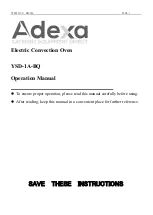
IMPORTANT SAFETY INSTRUCTIONS
(continued)
—
●
Do not use a thermometer in food you are
microwaving unless the
is designed
or recommended for use in the microwave oven.
●
Remove the temperature probe from the
oven when not using it to cook with. If you
leave the probe inside the oven without inserting
it in food or liquid, and turn on microwave energy,
it can create electrical arcing in the oven, and
damage oven walls.
Hot foods and steam can cause
.-..
burns. Be careful when opening any
containers of hot food, including
popcorn bags, cooking pouches and
prevent possible injury, direct steam away from
hands and face.
●
Plastic Cookware—Plastic cookware designed
for microwave cooking is very useful, but should
be used carefully. Even microwave-safe plastic
may not be as tolerant of overcooking conditions
as are glass or ceramic materials and may soften
or char if subjected to short periods of
overcooking. In longer exposures to overcooking,
the food and cookware could ignite. For these
reasons: 1) Use microwave-safe plastics only and
use them in strict compliance with the cookware
manufacturer’s recommendations. 2) Do not
subject empty cookware to microwaving. 3) Do
not permit children to use plastic cookware
without complete supervision.
●
Spontaneous boiling—Under certain ,
special circumstances, liquids may start
to boil during or shortly after removal
from the microwave oven. To prevent burns from
splashing liquid, stir the liquid briefly before
removing the container from the microwave oven.
. Use of the DOUBLE
shelf accessory.
—Remove the shelf from the oven when not in use,
—Do not store or cook with the shelf on the floor
of the oven, Product damage may result.
—--Use pot holders when handling the shelf and
cookware. They may be hot.
—Do not use a microwave browning dish on
the shelf. The shelf could overheat.. Use of
the shelf with the Automatic Cooking feature
is not recommended.
●
Not all plastic wrap is suitable for use
in microwave ovens. Check the package for
proper use.
●
cooking pouches and
tightly closed plastic bags should be
pierced or vented as directed on
the package. If they are not, plastic could burst
during or immediately after cooking, possibly
resulting in injury. Also, plastic storage containers
should be at least partially uncovered because
they form a tight seal. When cooking with
containers tightly covered with plastic wrap,
remove covering carefully and direct steam away
from hands and face.
6
Содержание JHP69GN
Страница 10: ...wFEATURES OF YOUR COOKING CENTER L I H 10 ...







































